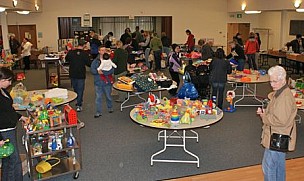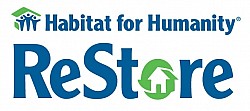March 11, 2014
 Reuse is at the top of the waste management hierarchy; however, it seldom receives the attention that recycling does. Beyond some basic promotional material development, relatively few municipalities and regional governments include reuse in there program development. Reuse is most generally defined as the “use of a product more than once in its same form for the same or similar purpose.”[1] Incorporating reuse in a waste management program assists communities to protect the environment while saving money and returning products and materials back into the economy benefiting society.
Reuse is at the top of the waste management hierarchy; however, it seldom receives the attention that recycling does. Beyond some basic promotional material development, relatively few municipalities and regional governments include reuse in there program development. Reuse is most generally defined as the “use of a product more than once in its same form for the same or similar purpose.”[1] Incorporating reuse in a waste management program assists communities to protect the environment while saving money and returning products and materials back into the economy benefiting society.
Economic and Social Benefits of Reuse
The economic value of recovered materials as reusable products (either as is, refurbished, repaired, or repurposed) can often provide greater economic and social benefits to a community than recycling. Reuse allows the value of materials to stay within the community, rather than sending value to recycling businesses outside the community or immediate region. More isolated small and Tribal communities can particularly benefit from reuse as recycling businesses are often located in high population communities or near transportation nodes to achieve economies of scale, making transportation of recyclables to market costly.
By contrast, reuse opportunities can thrive in smaller communities and contribute in significant ways to decreased solid waste generation and the local economy. Urban areas as well gain from keeping reusable resources local and supporting reuse businesses. Textiles and other items sold to regional or export markets also return monies to the local economy. Reuse, remanufacturing, repair, and refurbishment of products and parts can be economically beneficial for industry as well.
 Reuse encourages innovative, low cost, flexible, and local solutions to waste management. Communities benefit from avoided landfilling and transportation costs associated with shipping waste or recyclables out of the area. Reduced waste and transportation costs also translate into reduced pollution. Reuse can help businesses and local economies by creating jobs for refurbishing and selling materials, providing revenues for non-profit organizations, benefitting schools, and helping to keep reusable items within the community. And, especially in lower income communities, families benefit from opportunities to find free or low-cost, usable items.
Reuse encourages innovative, low cost, flexible, and local solutions to waste management. Communities benefit from avoided landfilling and transportation costs associated with shipping waste or recyclables out of the area. Reduced waste and transportation costs also translate into reduced pollution. Reuse can help businesses and local economies by creating jobs for refurbishing and selling materials, providing revenues for non-profit organizations, benefitting schools, and helping to keep reusable items within the community. And, especially in lower income communities, families benefit from opportunities to find free or low-cost, usable items.
In the United States, secondhand markets are billion dollar industries. Each year an estimated 40 million used cars are sold in the United States, nearly three times the number of new cars purchased. The amount of material processed through secondhand markets in this country is nearly as large as consumer recycling, while the economic value of secondhand markets is estimated to be far greater than that for recycling.[2]
Environmental Benefits of Reuse
 Waste is not just created when items are tossed in the garbage. Waste is generated throughout the life cycle of a product, from extraction of raw materials, to transportation and processing, and finally to its use and disposal. Reusing an item means that it continues to be a valuable, useful, and a productive item, replacing the need for new items that would utilize more water, energy, timber, petroleum, and other limited natural resources in their manufacture.
Waste is not just created when items are tossed in the garbage. Waste is generated throughout the life cycle of a product, from extraction of raw materials, to transportation and processing, and finally to its use and disposal. Reusing an item means that it continues to be a valuable, useful, and a productive item, replacing the need for new items that would utilize more water, energy, timber, petroleum, and other limited natural resources in their manufacture.
By reusing usable and salvageable items, substantial decreases in solid waste generation, greenhouse gases, energy and water consumption, and pollution can be achieved. For example, one ton of reused textiles saves more than 3 million gallons of water, 1,318 pounds of fertilizer, and 391 ounces of pesticides.[3] Reusing and recycling the raw materials from end-of-life electronics conserves natural resources and avoids the air and water pollution, as well as greenhouse gas emissions that are caused by manufacturing new products.[4] Reuse reduces the need to use natural resources to manufacture new products.
Giving Reuse More Attention
Government agencies and organizations can help to expand reuse in their communities by sponsoring ongoing reuse programs, such as material exchanges, teacher supply depots, and reuse sheds. Special events, including toy and “kid’s stuff” swaps, community-wide tag sales, textile drives, sports equipment exchange, and similar events bring numerous social and economic benefits to community residents. Government agencies can help to promote reuse by developing listings of ongoing reuse activities, thrift stores, and building reuse stores (e.g., “ReStores”) in their region.
Used goods are commonly available to industries, businesses, institutions, and individual consumers. “Secondhand” markets for manufacturing facilities—from textiles to chemical production—provide access to usable equipment and materials. Used industrial, construction, and medical equipment are also readily available. Used goods for individuals include cars, clothes, books, furniture, household items, sports equipment, musical instruments, and more. Sources of used goods include on-line auctions and markets for both commercial and individual consumers, secondhand stores, reuse building material stores, classified advertisements, estate sales, auctions, rummage sales, yard sales, salvage yards, materials exchanges, and trash salvaging or "dumpster diving."
Some reuse resources:
[1] http://www.calrecycle.ca.gov/reducewaste/define.htm#Reuse. The Reuse Alliance has other definitions, more on this in another blog!


Comments (1)
Arthur DeMarco:
Mar 27, 2018 at 12:44 PM
I like what you said about reuse reducing the need to use natural resources. It also helps your budget too. We try to shop at thrift stores as much as possible and that helps both agendas.
Add a Comment